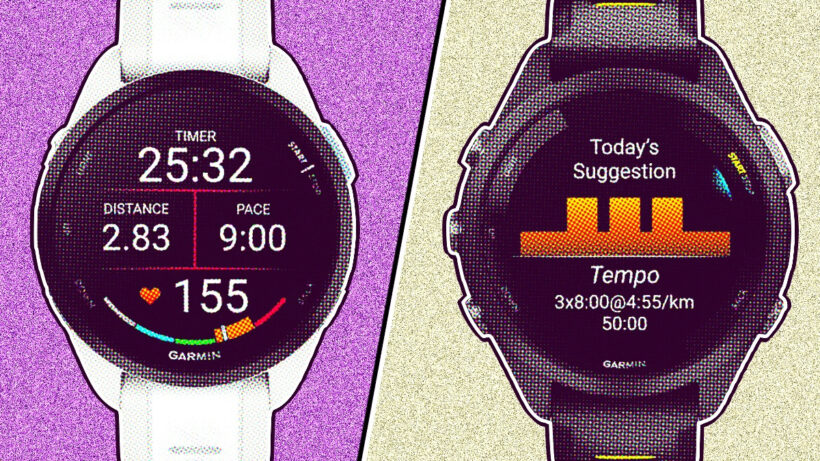Choose between this pair with help from our extensive breakdown
If you’re looking for a new running watch in 2025, there’s a good chance two of the options on your wish list are the Garmin Forerunner 165 and Forerunner 265.
And it’s no surprise—these are two of the best choices from the brand. They both feature sharp AMOLED screens, a variety of running-focused functions, and outstanding battery life.
Coming in at quite different price points, though, there are naturally plenty of differences to consider, too.
Fortunately for you, we’ve thoroughly tested both of these Garmin watches since their release. In this guide, we’ll provide expert insight into everything you need to know when comparing the 165 and 265.
More Garmin comparisons to check out:
- Forerunner 265 vs. Forerunner 965
- Forerunner 165 vs. Forerunner 55
- Forerunner 255 vs. Forerunner 265
Price, versions, and competition

- Garmin Forerunner 265: From $449 / £429
- Garmin Forerunner 165: From $249 / £249
Considering these two models sit next to each other in Garmin’s Forerunner lineup, there’s a significant price difference between the base editions. However, with the arrival of the pricier Forerunner 570 (the next-gen version of the 265) in early 2025, we’re also likely to see this gap shrink somewhat over the coming year or so.
In both lines, there are also two versions to choose from. The 165 is available with music support (for offline Spotify playback) or without, but adding this feature increases the price by a whopping $50/£50.
The 165 is also only available in one case size, which we’ll cover in more detail below. That’s not the case for the 265, which also has a smaller sibling, the 265S, to consider. However, this edition costs the same as the bigger version, unlike the 165’s separate variant.
These two lines sit in the middle of the wider Forerunner family. Above the 265 is the aforementioned 570, as well as the last-gen Forerunner 965, and flagship Forerunner 970.
The Forerunner 255 is also still available from around $349-$399 and is an excellent running watch for both beginners and seasoned runners.
Design and display

The same rough design language is present, regardless of whether you’re considering the 165 or 265, with both lines featuring the same silicon straps and fiber-reinforced polymer (plastic) cases.
Neither is more durable than the other in our experience, and you have to graduate to the Fenix 8 or 970 before dings and scrapes become less common.
It’s also true of the displays – we’ve picked up slight scuffs and scratches on all Forerunner models over the past few years, so keep this in mind if you’re clumsy like us and end up picking up either the 165 or 265.
Although they’re not the most durable, they’re both light and very comfortable to wear around the clock. The 165 clocks the scales at 39g, as does the 265S, with the standard 265 still only weighing 47g.

In terms of actual size, the 165 sits a little in between both variations of the 265. The case is 43mm with a 1.2-inch display, which splits the 265S (42mm, 1.1-inch display) and standard 265 (46mm, 1.3-inch display).
This isn’t hugely noticeable on the wrist, we don’t think, but we do still prefer the larger real estate of the 265—and the smaller-feeling edge that sits around the AMOLED display.
The standard 265 is perfect for most runners with medium or large wrists, although the 165 and 265S are still great designs for those with smaller wrists (or those who prefer not to wear larger watches while running).
The display quality is superb on both watches. We much prefer the clarity and brightness of AMOLED to the memory-in-pixel (MIP) screens of the past, and they’re also still extremely battery-efficient (as we’ll detail more below).
Running features, GPS, and heart rate

With nothing much distinguishing these two in design, the real differences begin to emerge when you examine the features you get (or don’t get) as a runner.
Despite the name, we prefer to view the 265 as Garmin’s most affordable triathlon watch – something that you might expect more from the 965. That’s because it effectively possesses all the running watch features you would expect from top-tier Garmin devices, and also includes support for more cycling- and swimming-centric analysis.
More advanced tracking and analysis are currently restricted to running only on the 165. Still, it also misses out on numerous training features we love on the 265, including Training Status, Daily Readiness, Endurance Score, Hill Score, and more.
It still offers some great features, including Garmin Coach, VO2 max estimations, HRV Status, Training Effect, Daily Suggested Workouts, and Race Predictor, as well as surprising additions like the company’s wrist-based Running Dynamics.

The core tracking elements: GPS and heart rate
However, the 265’s edge isn’t limited to software alone. It also represents the cheapest way to gain access to the more accurate dual-frequency GNSS (Multi-Band Mode) and SatIQ technology (Garmin’s way of automatically switching GPS modes to aid battery efficiency).
This might not make a huge difference if you don’t live in a built-up area, and the standard GNSS included in the 165 is more than accurate enough for most, but it’s a great tool to employ if accuracy is paramount. It also locks on much quicker than the 165, from our experience.
We should also note that both devices feature the same generation of Garmin’s Elevate optical heart rate sensor, the Elevate Gen 4. As we demonstrate in our comprehensive reviews of both devices, this sensor is very accurate. Even though it’s not as advanced as Garmin’s Elevate Gen 5 technology, it compares very well to a chest strap.
Health, smart, and sleep features

The 165 is much more basic than the 265 in terms of running features. Yet, these two models are again quite similar in their peripheral features, including sleep logging, stress tracking, advanced health monitoring, and smart features.
Since they run the same UI, you can expect the same support for iOS and Android notifications, and these look pretty good on AMOLED displays, even if that’s about where the smart support ends.
Both are capable of Garmin Pay and music support (if you get the 165), but you’re naturally limited to Garmin Connect IQ apps. And, to be clear, there’s no option in any of Garmin’s range for cellular/LTE support.
Elsewhere, as we say, things are very similar. Garmin’s sleep tracking has definitely improved in the last couple of years, but it still lags behind industry leaders Oura in our testing.
Both models feature Sleep Score and nightly reports, but, remember, only the 265 will use this data to inform your readiness and training. You can now access the new version of Body Battery on both platforms, which shows the net impact of events like stress, naps, and activity on your score.
If you’re looking for the kind of health features you’d expect from a smartwatch – ECG, heart rate notifications, fall/crash detection – then you’re out of luck. Both do feature HRV Status and Garmin’s Pulse Ox, though – the latter of which provides an insight (at the detriment of battery life) into your blood oxygen levels during sleep or around the clock.
Battery life

Despite their AMOLED displays, both of these running watch lines can deliver true multi-day battery life even with extensive use. Hours of GPS tracking with Spotify playback will only dent either a fraction, which is pretty incredible given the screen quality.
We’ve been unable to test the smaller 265S, but Garmin estimates that you’ll get slightly more battery life out of it than the 265, which is somewhat surprising. While the smaller variant offers 15 days in smartwatch mode, for example, this decreases to 13 days in the larger model.
It’s a similar story in Garmin’s various GNSS modes, and when you also tack on music streaming.
In our review testing of the 265, which included the brightness maxed out, the always-on display (AOD) enabled, Pulse Ox turned on, and plenty of SatIQ tracking and music streaming, we observed around four days of battery life. It can get closer to a week if you use it less intensively.
For the 165, you can expect better battery life. Garmin estimates 11 days of smartwatch mode use, and our setup (the same as we used for the 265, except for music streaming) lasted around seven days. Very impressive.
As we say, both provide more than enough for those planning to put it through serious endurance tests, or those who don’t want to charge something every day or two.
Verdict: Which is best?

Knowing which is the best option for you is all about understanding your budget and needs, and, as illustrated above, these are running watches with two quite distinct profiles.
Our recommendations have also been updated for 2025, as Garmin has released a new generation of premium Forerunner devices. Here’s what we advise:
- Choose the Forerunner 165 if you’re looking for a current-gen Garmin watch to begin your run-tracking journey. It offers excellent accuracy in the core areas—HR and GPS—considering the price, and the battery life and design are also excellent.
- Choose the Forerunner 265 if you’re looking to take your training insights and race-day prep to the next level—but don’t want to pay for the 570, 965, or 970. The 265 remains the top mid-range option for most people, given its balance of affordability and advanced features.




